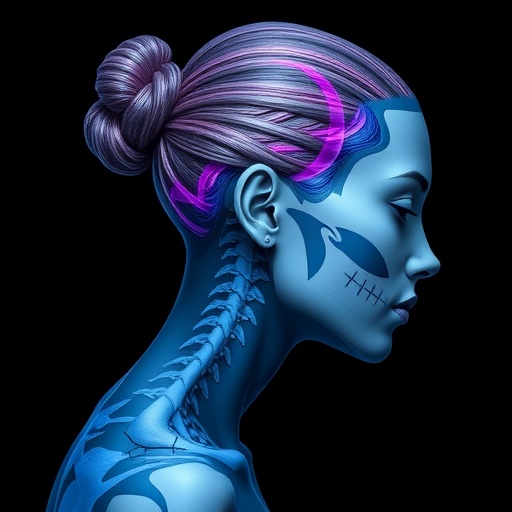In a poignant exploration of personal experience entwined with scientific inquiry, the recent study by Locke and Eastman delves into the enigmatic realm of Ehlers–Danlos syndrome (EDS). This connective tissue disorder, characterized by hyper-flexibility, skin elasticity, and fragility, has long been misunderstood in both clinical and social contexts. The authors present a unique autobiographical case study that not only sheds light on the symptoms and challenges faced by individuals with EDS but also navigates the intricate psychosocial dimensions often overlooked in medical literature.
Ehlers–Danlos syndrome is not merely a clinical condition; it is an intricate tapestry of physiological and psychological experiences that significantly impact the lives of those diagnosed. The study emphasizes how these experiences are often distorted by societal misconceptions and a lack of awareness, leading to feelings of isolation and misunderstanding among patients. Locke and Eastman’s narrative serves as a powerful testament to the persistent struggles and conflicts within the social fabric faced by individuals living with EDS.
In their groundbreaking paper, the authors outline the common symptoms of EDS, including joint hypermobility, chronic pain, and vulnerability to injury, but they go a step further. They articulate the emotional labyrinth that patients traverse, where chronic pain is intertwined with psychological distress, resulting in anxiety and depression. Such intertwining of physical and mental health is imperative to understand for effective management and support of patients.
The emotional tolls of living with EDS cannot be underestimated. Patients often face skepticism from healthcare professionals, friends, and family who may misinterpret their symptoms or not recognize the validity of their experiences. Locke and Eastman emphasize that the journey toward diagnosis is frequently fraught with difficulties, as individuals are often undiagnosed or misdiagnosed for years. This delay not only exacerbates their physical ailments but also contributes to psychological trauma, leading to mistrust in the healthcare system.
Through vivid personal accounts, the authors illustrate the profound impact of EDS on identity and self-perception. Individuals may grapple with feelings of inadequacy and frustration as they attempt to navigate a world that was not designed for their unique needs. The psychosocial landscape depicts a series of battles; the struggle is not just against the physical limitations imposed by EDS but against societal narratives that often marginalize these experiences.
Locke and Eastman also provide insights into the coping mechanisms that can be vital for individuals navigating life with EDS. Their case study reveals the importance of community support, whether through online forums or local support groups where individuals share their experiences and foster understanding. This peer connection can offer comfort and validation, acting as a buffer against the pervasive feelings of isolation that often accompany chronic conditions.
Moreover, the authors advocate for a comprehensive approach to EDS treatment, one that incorporates psychological support alongside physical health management. They highlight the crucial role of interdisciplinary care involving rheumatologists, psychologists, and occupational therapists, emphasizing the need for a holistic view of treatment. Such collaboration ensures that individuals receive well-rounded care, addressing both physical symptoms and emotional well-being.
In an era that increasingly recognizes the significance of mental health, Locke and Eastman’s study pushes for further recognition of how chronic physical conditions like EDS can alter psychological landscapes. They urge healthcare professionals to foster environments conducive to open dialogues about mental health, ensuring that patients feel safe to express their struggles without fear of dismissal or misunderstanding.
The authors’ personal storytelling adds an evocative layer to the scientific discourse, bridging the gap between clinical research and real-world experiences. By humanizing the statistics, their autobiographical narrative allows readers to empathize with the unique struggles of those with Ehlers–Danlos syndrome. This narrative approach could well serve as a model for future medical research that seeks to blend rigorous academic inquiry with the humane elements of personal experience.
Despite the strides made in understanding EDS, the journey toward widespread awareness and education remains long. As Locke and Eastman point out, societal education about EDS is crucial to mitigate the stigma and misunderstandings surrounding the condition. Their work encapsulates a clarion call for greater advocacy and awareness campaigns that aim to transform public perceptions and enhance the lives of individuals affected by this syndrome.
As the study concludes, it reiterates the urgency of integrating patient narratives into medical education and practice. Empathy, understanding, and support can drastically improve the quality of life for individuals living with EDS. By recognizing the interplay between physical health and psychosocial factors, healthcare professionals can better serve their patients, creating a compassionate care model that is crucial for chronic health conditions.
Locke and Eastman’s engaging exploration serves not only as a resource for medical professionals but also as an uplifting beacon of hope for individuals with Ehlers–Danlos syndrome. As the conversation around chronic illnesses continues to evolve, the incorporation of patient experiences will undoubtedly pave the way for a more inclusive and informed healthcare landscape, benefiting both individuals and society as a whole.
The compelling narratives and thought-provoking insights provided in this study underscore the need for continual research and advocacy. There is much to be learned from the experiences of those navigating life with EDS, and it is imperative that their voices are heard, acknowledged, and valued within the wider medical discourse. Ultimately, Locke and Eastman’s case study illuminates a path forward, one where understanding and empathy are as integral to treatment as the science itself.
Subject of Research: Ehlers–Danlos Syndrome and its psychosocial implications.
Article Title: Navigating the psychosocial landscape of Ehlers–Danlos syndrome: an autobiographic case study.
Article References:
Locke, J.D., Eastman, J.T. Navigating the psychosocial landscape of Ehlers–Danlos syndrome: an autobiographic case study.
Discov Ment Health 5, 123 (2025). https://doi.org/10.1007/s44192-025-00268-5
Image Credits: AI Generated
DOI:
Keywords: Ehlers–Danlos syndrome, psychosocial impact, chronic illness, patient experience, interdisciplinary care.




